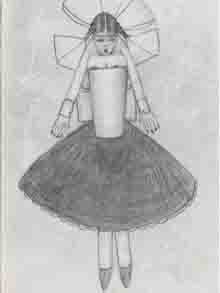
Mannequin with Bows 1960s
As the master of scenes depicting urban life in the North, the artist LS Lowry is best known for his trademark red-brick buildings and "matchstick men" figures, which feature in his most famous paintings. But previously unseen erotic drawings by the artist of partially-clad women are to be displayed for the first time, revealing a hidden passion to Lowry's work. Three sketches of ballerina-like figures with their breasts exposed, thought to have been drawn by Lowry when he was in his eighties, will be unveiled later this month The figures are dressed in tight and revealing corset-style bodices, with tutu shaped skirts decorated with bows. The sketches, which are thought to date from the early 1970s, show two of the figures standing in the ballet pose "en pointe". The drawings have since remained in the artist's private archive which, along with the rest of his estate, passed to Carol Ann Lowry, on his death in 1976.

Miss Lowry, who is no relation of the artist, had written to him, in 1957, when, aged 13, she was urged by her mother to ask for his advice on how to become a painter. After receiving the letter, Lowry made a surprise visit to Miss Lowry's home in Lancashire and their friendship was to last for the rest of his life. Miss Lowry has agreed for them to be displayed at a new exhibition dedicated to the Royal Ballet and its founder, Ninette de Valois, at The Lowry gallery in Salford.
A shy and secretive artist who remained unmarried until his death, at the age of 88, Lowry once admitted that he had "never had a woman". But as a keen ballet-goer who regularly attended performances by the Royal Ballet at Covent Garden and in his home city of Manchester, it appears the ballet and its dancers including Margot Fonteyn and de Valois, may have stirred a latent passion in the artist.
Claire Stewart, the curator of the LS Lowry collection at the gallery and co-curator of Invitation to the Ballet: Ninette de Valois and the Story of the Royal Ballet, said: "They are highly detailed works and he obviously took a lot of time and care over them. "Lowry particularly loved the ballet Coppelia, and the poses in the drawings appear to reference that work, although given the erotic undertones, it's unlikely that he ever intended to exhibit them publicly.
"They are very surprising images and could not be more different from the industrial scenes we associate with Lowry, but he was a mysterious, multifaceted man with complex human emotions, and these late works are an expression of some of these feelings." The exhibition, tells the story of the Royal Ballet from its foundations in the 1920s to the present day, highlighting Lowry's involvement in ballet and how his appreciation of art, music and dance affected his work. It will feature several of Lowry's portraits of "Ann", an enigmatic figure with stylised features whom he often spoke of as a real person, though speculation persists as to her identity.
Some Lowry experts argue that she was a figment of his imagination or composite of his ideal woman, while others believe that she is based on the character of Swanilda from Coppelia, which Lowry is thought to have first seen performed during the Second World War. The exhibition will also display costumes worn by some of the greatest names in ballet including Darcey Bussell, Rudolf Nureyev and Fonteyn, alongside costume and set designs by artists including Pablo Picasso and Rex Whistler.
A brief biography and history of the artist
L.S.Lowry
Laurence Stephen Lowry did not like to think about himself as an novice artist.
Individuals would occasionally accuse him of being self-taught and untutored. he commented,
"Started at fifteen years old. Don't know why?" My aunt stated "You seem to be no good for anything,
so you may as well go to Art School."
LSLowry started evening courses in antique art and free hand art drawing during 1905.
Later becoming a student in each the Manchester Academy of Fantastic Art and The Salford Royal Technical College at Peel Park.
College records present that Lowry attended art classes through the 1920's. Lowry had learnt from academics,
individuals such as the Frenchman Adolphe Valette.